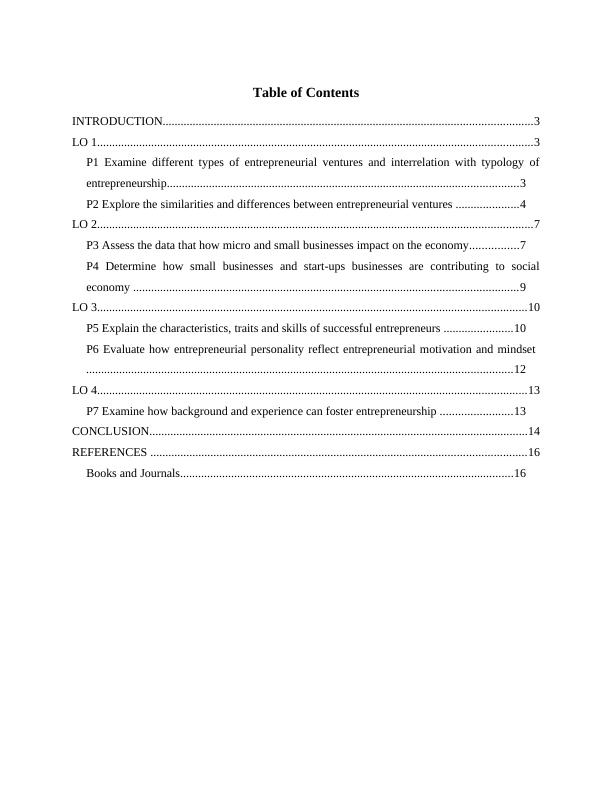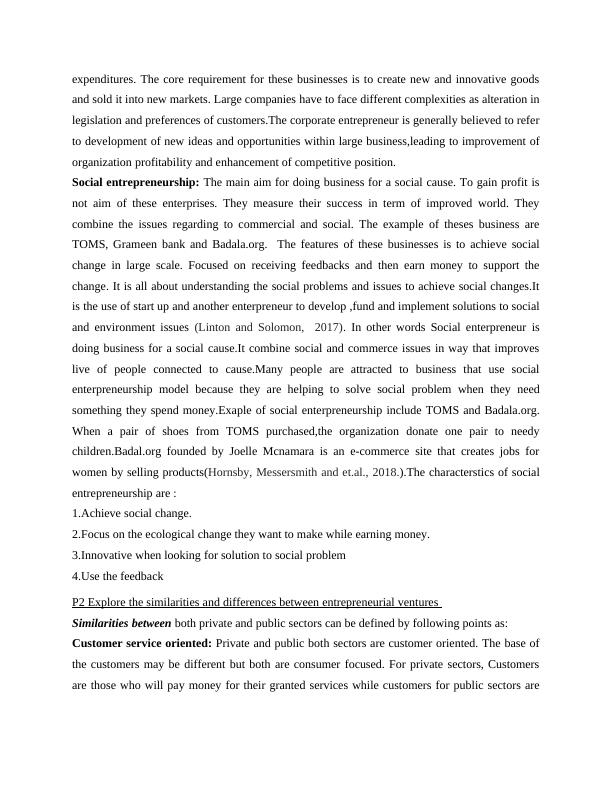Entrepreneurship and Small Business Management Typology
Added on 2020-10-05
17 Pages5213 Words285 Views
Entrepreneurship and Small Business Management

Table of ContentsINTRODUCTION...........................................................................................................................3LO 1.................................................................................................................................................3P1 Examine different types of entrepreneurial ventures and interrelation with typology ofentrepreneurship.....................................................................................................................3P2 Explore the similarities and differences between entrepreneurial ventures .....................4LO 2.................................................................................................................................................7P3 Assess the data that how micro and small businesses impact on the economy................7P4 Determine how small businesses and start-ups businesses are contributing to socialeconomy ................................................................................................................................9LO 3...............................................................................................................................................10P5 Explain the characteristics, traits and skills of successful entrepreneurs .......................10P6 Evaluate how entrepreneurial personality reflect entrepreneurial motivation and mindset ..............................................................................................................................................12LO 4...............................................................................................................................................13P7 Examine how background and experience can foster entrepreneurship ........................13CONCLUSION..............................................................................................................................14REFERENCES .............................................................................................................................16Books and Journals...............................................................................................................16

INTRODUCTIONIn order to define entrepreneurship and small businesses, this report consider all theventures of entrepreneurs and also describe the similarities and differences between private andpublic sectors. In addition to this, assessment and interpretation of data are also explained in thisresearch investigation. Data analysis is done to illustrate the impacts of small businesses onsocial economy. They play an important role in growth of the economy. A successfulentrepreneur have characteristic, skills and traits which differentiate them from other businessmanagers. The main factor which motivate and change the mindset of the entrepreneurs ispersonality. Apart from this, this report also examine the background and experience factorwhich can hinder entrepreneurship. LO 1P1 Examine different types of entrepreneurial ventures and interrelation with typology ofentrepreneurshipEntrepreneurship of small business: The example of these types of businesses are grocerystores, consultants, plumbers and electricians. Mostly these businesses hires local people. Themain objectives of these companies to gain more profits. The goal is to feed their familymembers then make a profit. They do not have willingness to take over the industry or any otherfirm. The funding system of small business entrepreneurship are there family members andfriends. The entrepreneur and small business are areas that are constantly evolving ,requiringcreative minds that are willing to play with coniderable level of risk.It is common field of studyfor all the students studying business or who are interested in starting their ownbusiness.Education information includes that to become entrepreneur degree is not reqired(Nabi,Linan and et.al. 2017).Entrepreneurship of scalable start-up: The objective of the business is to change the world bycreate new brands in the products and developing big marketplace. The level of risk and return isunreasonable. They have willingness to make best of their wealth and time. Other features of thisentrepreneurship is to cut down the incoming cost and provide high quality of freedom.Entrepreneurship of large company: These businesses creates bigger movements andmodifications in the price of the company. These companies have different advantages as abilityto economic expansion, talent to attract customers, promotional benefits, low cost of overhead

expenditures. The core requirement for these businesses is to create new and innovative goodsand sold it into new markets. Large companies have to face different complexities as alteration inlegislation and preferences of customers.The corporate entrepreneur is generally believed to referto development of new ideas and opportunities within large business,leading to improvement oforganization profitability and enhancement of competitive position.Social entrepreneurship: The main aim for doing business for a social cause. To gain profit isnot aim of these enterprises. They measure their success in term of improved world. Theycombine the issues regarding to commercial and social. The example of theses business areTOMS, Grameen bank and Badala.org. The features of these businesses is to achieve socialchange in large scale. Focused on receiving feedbacks and then earn money to support thechange. It is all about understanding the social problems and issues to achieve social changes.Itis the use of start up and another enterpreneur to develop ,fund and implement solutions to socialand environment issues (Linton and Solomon, 2017). In other words Social enterpreneur isdoing business for a social cause.It combine social and commerce issues in way that improveslive of people connected to cause.Many people are attracted to business that use socialenterpreneurship model because they are helping to solve social problem when they needsomething they spend money.Exaple of social enterpreneurship include TOMS and Badala.org.When a pair of shoes from TOMS purchased,the organization donate one pair to needychildren.Badal.org founded by Joelle Mcnamara is an e-commerce site that creates jobs forwomen by selling products(Hornsby, Messersmith and et.al., 2018.).The characterstics of socialentrepreneurship are :1.Achieve social change.2.Focus on the ecological change they want to make while earning money.3.Innovative when looking for solution to social problem4.Use the feedbackP2 Explore the similarities and differences between entrepreneurial ventures Similarities between both private and public sectors can be defined by following points as:Customer service oriented: Private and public both sectors are customer oriented. The base ofthe customers may be different but both are consumer focused. For private sectors, Customersare those who will pay money for their granted services while customers for public sectors are

End of preview
Want to access all the pages? Upload your documents or become a member.
Related Documents
ENTREPRENEURSHIP AND SMALL BUSINESS ENTERPRISE TABLE OF CONTENTSlg...
|18
|4717
|383
(PDF) Introduction to Entrepreneurship : Assignmentlg...
|19
|5442
|2473
Unit 09: Entrepreneurship and Small Business Management Assignmentlg...
|14
|4749
|436
Entrepreneurship and Small Business Management Strategies (pdf)lg...
|17
|5090
|87
Entrepreneurship and Small Business Managementlg...
|20
|5658
|92
Small Business and Entrepreneurshiplg...
|18
|5243
|271
